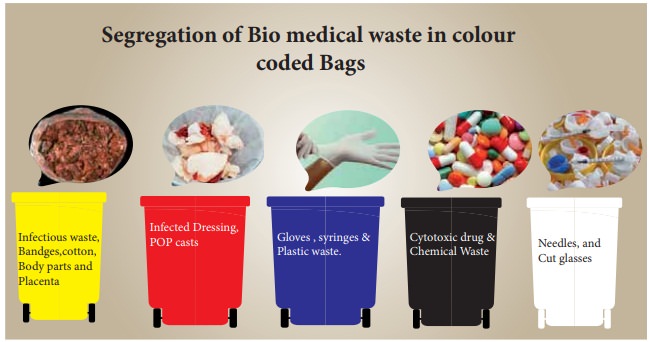
Project On Biomedical Waste For Class 12
Acknowledgement:
In the process of completing this project on biomedical waste, I would like to take a moment to extend my heartfelt gratitude to [Name], our esteemed teacher. Their unwavering commitment to education and their profound knowledge in the field have truly enriched this endeavor.
The successful culmination of any project is the result of dedicated guidance, and in this regard, [Name]’s contribution has been invaluable. Their willingness to patiently listen to our ideas, clarify our doubts, and provide constructive feedback has transformed this project into a meaningful learning experience.
Throughout the course of this project, [Name] consistently demonstrated their passion for the subject matter and their dedication to fostering a deep understanding of the complexities of biomedical waste management. Their encouragement and belief in our capabilities have motivated us to delve deeper, explore further, and aim higher in our pursuit of knowledge.
I am genuinely grateful for the mentorship that [Name] has provided, not only for the technical insights and academic guidance but also for the inspiration to approach challenges with curiosity and determination. Their mentorship has not only shaped the content of this project but has also influenced my personal growth as a student and an individual.
In closing, I wish to extend my warmest appreciation to [Name]. Their role as a mentor and educator has left an indelible mark on my academic journey, and I am confident that the lessons learned during the completion of this project will continue to resonate in my future endeavors. Thank you for being a guiding light and a source of inspiration.
Introduction:
In the contemporary landscape, the meticulous handling and responsible disposal of biomedical waste have risen to the forefront of global concern, spurred by its far-reaching implications for both public health and the delicate balance of our environment. Biomedical waste, often referred to as medical waste, encompasses a diverse array of discarded materials that originate from healthcare activities and possess the potential to jeopardize human well-being and ecological stability. In recognition of the pressing need to address this multifaceted challenge, the primary objective of this project is to embark on a comprehensive exploration of the multifaceted realm of biomedical waste.
Biomedical waste’s intricate web of implications necessitates a deeper understanding and heightened awareness of its intricacies. This undertaking aims to illuminate the multifarious dimensions of biomedical waste, including its origins, composition, and potential consequences, both immediate and long-term. By delving into this complex landscape, we seek to unravel the significance of managing biomedical waste effectively, unraveling the threads that link this issue to public health, environmental conservation, and sustainable development.
The scope of this project extends beyond mere description, aiming to dissect the challenges that surround biomedical waste and offer viable solutions to mitigate its impact. It is imperative to underscore the gravity of the issue and underscore the urgency of establishing a cohesive framework that safeguards both the well-being of individuals and the ecological equilibrium of our planet. In doing so, we aspire to contribute to a well-informed discourse that prompts action and encourages stakeholders, from healthcare professionals to policymakers and the wider community, to join hands in addressing this critical concern.
Through a meticulous examination of the various facets of biomedical waste, this project endeavors to foster an enhanced appreciation for the intricacies inherent in its management. By illuminating the interplay between medical practices, waste generation, and potential risks, we endeavor to equip ourselves with the knowledge required to foster responsible behavior and effective strategies. In the subsequent sections of this project, we will journey through the categorization of biomedical waste, explore real-world examples, shed light on the significance of managing this waste stream, and ultimately lay the groundwork for a comprehensive approach to its management.
In essence, this project serves as a beacon, guiding us through the intricate pathways of biomedical waste management, unveiling the opportunities for positive change, and underscoring the collective responsibility that we bear in shaping a healthier and more sustainable world. Through diligent analysis, critical inquiry, and a commitment to informed decision-making, we embark on this journey with the aspiration to contribute meaningfully to the discourse surrounding biomedical waste and inspire tangible actions that lead to a brighter future for all.

Definition of Biomedical Waste:
The term “biomedical waste” encapsulates a diverse and intricate array of materials that find their origins within the dynamic realm of healthcare establishments, spanning the expanse of hospitals, clinics, research centers, and laboratories. This encompassing definition encompasses not only the physical spaces where healing and scientific exploration occur but also the broader responsibilities inherent in preserving public health and safeguarding the environment.
Within the confines of this definition lie an assortment of items, each bearing a distinct role in the continuum of healthcare delivery. Among these items, discarded sharps, embodying the likes of needles, syringes, and scalpels, stand as potent symbols of medical intervention, representing the delicate balance between progress and precaution. Contaminated dressings, marked by the evidence of care and treatment, find their place within this expansive definition, mirroring the ceaseless efforts of healthcare providers to mend and restore.
Blood-soaked materials, testament to the human body’s intricate nature and its inherent vulnerabilities, form a significant component of biomedical waste. These materials bear witness to the intricacies of medical procedures, reflecting both the hopes of healing and the reality of healthcare’s challenges. Pathological waste, representative of the microscopic realm, contributes to this definition, underscoring the imperative of safe handling and containment due to its potential to harbor infectious agents.
A defining characteristic of biomedical waste is its potential to bear hazardous or infectious properties, placing an inherent responsibility upon those who handle, manage, and ultimately determine its fate. Pharmaceuticals, once the symbols of healing and relief, find themselves integrated within this expansive definition, signifying the dual nature of substances that can both save and potentially harm. Beyond these notable examples, a myriad of other items traverse the spectrum of biomedical waste, each deserving of attention and prudent consideration.
In summary, the definition of biomedical waste extends beyond the mere delineation of materials; it encompasses the essence of healthcare itself. It embodies the stories of healing and restoration, the pursuit of scientific understanding, and the interplay between progress and preservation. By acknowledging the breadth of this definition, we begin to appreciate the intricate responsibilities associated with its management—a collective endeavor that echoes the reverence for life, the stewardship of resources, and the pursuit of knowledge that define the tapestry of human well-being.

Types of Biomedical Waste:
Biomedical waste, originating from the diverse landscape of healthcare activities, undergoes a systematic classification into distinct categories, a practice vital for its prudent handling and effective management. These categories are determined by the intrinsic properties of the waste, delineating potential risks and guiding appropriate protocols. The following are the key types into which biomedical waste is commonly categorized:
Infectious Waste: This category encompasses materials that carry infectious agents capable of causing disease in humans or other living organisms. It includes items contaminated with blood, bodily fluids, cultures, stocks, and specimens of microorganisms. Due to the potential for transmitting infections, meticulous handling and disposal are imperative to prevent the spread of diseases.
Hazardous Waste: Biomedical waste possessing hazardous characteristics due to its chemical properties or potential to cause harm falls within this category. Such waste may include discarded chemicals, pharmaceuticals with hazardous components, and materials contaminated with heavy metals. Effective management of hazardous waste mitigates the risk of environmental contamination and adverse health effects.
Radioactive Waste: Radioactive materials utilized in diagnostic and therapeutic procedures generate this category of biomedical waste. Items such as used radiation therapy sources, contaminated clothing, and other radioactive materials require specialized handling and disposal methods to prevent radiation exposure and long-term environmental damage.
Pharmaceutical Waste: Pharmaceuticals, while often beneficial, can pose risks when improperly disposed of. Expired, unused, or partially used medications fall into this category. Inappropriate disposal may lead to water pollution, the development of antibiotic resistance, and other environmental concerns. Proper disposal mechanisms ensure the safe elimination of pharmaceutical waste.
Non-Hazardous General Waste: Within healthcare facilities, not all waste carries the same level of risk. Non-hazardous general waste includes items that do not pose immediate threats to human health or the environment. These could be packaging materials, paper, and non-contaminated personal protective equipment. While not directly hazardous, these items still necessitate responsible disposal to promote cleanliness and order within healthcare settings.
Categorizing biomedical waste based on its distinct characteristics allows for tailored management strategies, catering to the unique challenges each type presents. The significance of adhering to these classifications lies in the prevention of contamination, reduction of health risks, and preservation of the environment. By diligently recognizing and respecting the diverse types of biomedical waste, we contribute to a safer, more resilient healthcare system that upholds the principles of public health and environmental stewardship.

Examples of Biomedical Waste:
The realm of biomedical waste encompasses a plethora of objects, each with its own narrative and significance within the framework of healthcare. These examples stand as poignant reminders of the intricate intersection between medical practices, human well-being, and environmental preservation. Among the diverse array of biomedical waste, the following examples shed light on the multifaceted nature of this category:
Used Syringes: These slender instruments, once wielded in the pursuit of healing, epitomize the delicate balance between medical intervention and potential risk. Used syringes, having come into contact with bodily fluids, fall within the realm of infectious waste. Proper disposal ensures that the potential for disease transmission is minimized.
Blood-Soaked Bandages: Testaments to medical care and intervention, blood-soaked bandages embody the essence of healing and recovery. However, they also fall into the category of infectious waste due to the potential presence of pathogens. Safely handling and discarding such materials is essential to prevent the spread of infections.
Cultures, Stocks, and Specimens of Microorganisms: Laboratories and research facilities often generate waste in the form of cultures, stocks, and specimens of microorganisms. These materials, while pivotal for scientific exploration, carry the potential for containing infectious agents. Proper disposal of such items is imperative to mitigate any risks to laboratory personnel and the environment.
Discarded Surgical Gloves: A fundamental component of infection control, surgical gloves find their way into biomedical waste streams due to their potential contamination. These protective barriers, though integral to patient care, exemplify the delicate dance between safeguarding health and managing waste responsibly.
Outdated or Unused Pharmaceuticals: Pharmaceuticals, once agents of relief and recovery, may become obsolete or unused. Such medications, if improperly disposed of, can contribute to environmental pollution and potential health hazards. Proper disposal mechanisms, often involving pharmaceutical take-back programs, help prevent these negative outcomes.
The significance of these examples extends beyond their physical presence; they serve as symbolic representations of the complexities that healthcare professionals navigate daily. The careful handling and appropriate disposal of these materials reflect a commitment to both patient well-being and the broader ecosystem.
These examples underscore the intricate relationship between medical practices and waste management, encapsulating the dual responsibility of healing and preserving. They emphasize the need for awareness, education, and adherence to established protocols to ensure that these materials, once instruments of care, do not inadvertently contribute to harm. In essence, these examples of biomedical waste illuminate the path toward responsible and sustainable healthcare practices that prioritize both human health and the well-being of our shared environment.
Importance of the Project on Biomedical Waste:
The significance of embarking on a project centered around the management of biomedical waste cannot be overstated. This undertaking holds profound implications for both the immediate well-being of individuals and the broader ecological equilibrium of our planet. The urgency of addressing this issue is underscored by the potential consequences that improper biomedical waste disposal can unleash.
Public Health and Disease Prevention: At the heart of the matter lies the imperative to protect public health. Improper management of biomedical waste has the potential to serve as a breeding ground for infectious agents and pathogens, thereby escalating the risk of disease transmission. Contaminated materials, if not appropriately handled and disposed of, can lead to the spread of infections among healthcare workers, waste handlers, and the general population. By implementing effective biomedical waste management strategies, we mitigate these risks, safeguarding the health and well-being of both individuals and communities.
Environmental Preservation: The consequences of neglecting proper biomedical waste management extend beyond human health, permeating into the very fabric of our environment. Incorrect disposal can result in the contamination of water bodies and soil, triggering a cascading series of ecological disruptions. Harmful chemicals, pathogens, and pollutants can leach into the surrounding environment, infiltrating water sources, soil, and even the food chain. This can have far-reaching and long-lasting effects on the delicate balance of ecosystems, wildlife, and the overall sustainability of our planet.
Sustainable Development: The management of biomedical waste aligns with the principles of sustainable development, emphasizing the responsible utilization of resources to meet the needs of the present without compromising the needs of future generations. By addressing this issue, we contribute to the preservation of natural resources, reduction of pollution, and overall enhancement of environmental quality. This, in turn, fosters a foundation upon which communities can thrive and prosper in harmony with their surroundings.
Societal Awareness and Education: Initiatives centered around biomedical waste management provide an avenue to raise awareness and educate various stakeholders, from healthcare professionals to the general public. Through education, individuals gain insights into the potential risks associated with improper waste disposal and the methods to mitigate them. By fostering a culture of responsible waste management, we empower individuals to make informed choices that collectively contribute to a healthier and safer society.
In conclusion, the importance of a project focused on biomedical waste management resonates on multiple fronts—health, environment, sustainability, and societal well-being. By delving into the complexities of this issue, we not only cultivate a deeper understanding of its ramifications but also inspire action and change. Through concerted efforts to raise awareness, educate, and implement effective waste management practices, we lay the groundwork for a future where biomedical waste no longer poses a threat to our health, our environment, and the legacy we leave for generations to come.
Methods to Manage Biomedical Waste:
The effective management of biomedical waste is an intricate endeavor that demands a systematic and coordinated approach to ensure the safeguarding of public health and the environment. This multifaceted process encompasses a sequence of critical steps, each playing a pivotal role in mitigating the potential risks associated with biomedical waste. The following methods constitute a comprehensive framework for the responsible management of biomedical waste
Segregation at the Source: The foundation of efficient biomedical waste management lies in the practice of segregation at its source, where waste is generated. This fundamental step involves categorizing waste into distinct types based on its characteristics, such as infectious, hazardous, or non-hazardous waste. By segregating waste at its point of origin, healthcare facilities lay the groundwork for the subsequent stages of management, ensuring that each waste type is handled appropriately.
Proper Use of Color-Coded Bins: Color-coded bins serve as a visual aid to facilitate the segregation process. Different colors correspond to specific waste categories, providing a clear and intuitive system for waste handlers to identify and sort biomedical waste accurately. Adhering to color-coded bin systems helps minimize the risk of cross-contamination and ensures that waste is directed toward the appropriate treatment and disposal methods.
Adherence to Guidelines: The management of biomedical waste is governed by stringent guidelines and regulations that vary by region. These guidelines stipulate the proper handling, storage, transportation, treatment, and disposal of different waste types. Healthcare facilities and waste handlers must stay informed about these regulations and implement them rigorously to maintain compliance and minimize risks.
Collection and Storage: Collected biomedical waste is stored in designated containers that meet safety and hygiene standards. These containers are designed to prevent leakage, breakage, and tampering. Storage areas should be secure, well-ventilated, and accessible only to authorized personnel to ensure the safety of both workers and the surrounding environment.
Transportation: Transportation of biomedical waste from healthcare facilities to treatment and disposal sites is a critical stage that demands careful planning and execution. Specialized vehicles equipped to handle biomedical waste are used to prevent spillage, contamination, and exposure. Compliance with transportation regulations guarantees that waste is conveyed safely and effectively.
Treatment and Disposal: The treatment and disposal of biomedical waste are pivotal steps in the management process. Depending on the waste type, treatment methods may include autoclaving (steam sterilization), incineration, chemical disinfection, or other approved techniques. These methods neutralize pathogens and reduce the potential for harm. The choice of treatment method is guided by regulatory standards and the nature of the waste.
Monitoring and Documentation: Regular monitoring and documentation of waste management activities are essential for accountability and continuous improvement. Keeping accurate records ensures that waste is properly tracked throughout its lifecycle, from generation to final disposal, enabling audits and assessments of waste management practices.
In essence, the methods to manage biomedical waste encompass a comprehensive approach that spans from the point of waste generation to its ultimate treatment and disposal. A well-coordinated strategy that encompasses segregation, proper use of color-coded bins, adherence to guidelines, secure collection and storage, safe transportation, effective treatment, and thorough documentation forms the backbone of responsible biomedical waste management. By adhering to these methods, healthcare facilities contribute to a safer environment, improved public health, and the preservation of precious natural resources.
Three Pillars of Effective Biomedical Waste Management:
1. Awareness and Training: Educating healthcare professionals, waste handlers, and the general public about the risks associated with biomedical waste and imparting proper handling techniques is fundamental.
2. Infrastructure and Equipment: Establishing well-equipped waste collection centers, treatment facilities, and incinerators, along with providing necessary safety gear, ensures safe handling and disposal.
3. Regulations and Policies: Implementing and enforcing stringent regulations and guidelines for the proper management of biomedical waste helps maintain compliance and accountability.
Conclusion:
In the final analysis, the intricate realm of biomedical waste management stands as a testament to the intersection of legality and morality, underscoring our shared commitment to preserving both public health and the delicate equilibrium of our environment. It serves as a potent reminder that our actions reverberate beyond the confines of healthcare facilities, echoing through the corridors of societal well-being and ecological resilience.
The journey through this exploration has illuminated the multifaceted facets of biomedical waste – from its diverse types to the meticulous methods that underpin its effective management. The conscientious segregation at its source, the vigilant use of color-coded bins, and the steadfast adherence to established guidelines serve as the cornerstones of a comprehensive strategy that transcends mere waste disposal.
This endeavor extends beyond the realm of compulsion, embracing a moral imperative that demands a deeper understanding and a heightened sense of responsibility. The knowledge gleaned from comprehending the nuances of biomedical waste empowers us to be active participants in nurturing a healthier environment and safeguarding the health of communities.
Through the lens of awareness, education, and the unwavering commitment to established protocols, we embark on a shared trajectory toward a transformed future. A future in which the ominous shadow cast by biomedical waste dissipates, giving way to a landscape where health is upheld, and the environment flourishes unhindered.
As this chapter draws to a close, let us collectively carry forth the insights gained from this exploration, integrating them into our daily practices and fostering a culture of conscientious waste management. By harnessing the potential of our individual and collective actions, we can forge a path towards a world where biomedical waste ceases to be a threat and becomes a testament to our ability to harmonize the intricate interplay between human progress and environmental preservation. Together, we lay the foundation for a future where the echoes of responsible biomedical waste management resonate across generations, reminding us of our shared duty to leave behind a legacy of wellness, sustainability, and thriving ecosystems.
Certificate of Completion
I, [Your Name], am pleased to confirm that I have finished the assignment on “Biomedical Waste Management.” I now have a thorough awareness of the crucial factors pertaining to the management of biomedical waste in healthcare settings as a result of this research.
I have examined and addressed a number of aspects of biomedical waste throughout this research, including its types, examples, management techniques, and the crucial three pillars of efficient biomedical waste management. I’ve learned a lot about the need of appropriate trash management for maintaining the environment, encouraging sustainability, and raising public awareness and educational levels.
This credential recognises my dedication to studying and advancing ethical procedures for managing biological waste. I am eager to use the knowledge and abilities I have gained from working on this project to positively impact healthcare and environmental preservation initiatives.
Date: [Date of Finish]
Please sign below.
In order to download the PDF, You must follow on Youtube. Once done, Click on Submit
Follow On YoutubeSubscribed? Click on Confirm
Download Project On Biomedical Waste For Class 12 PDF






